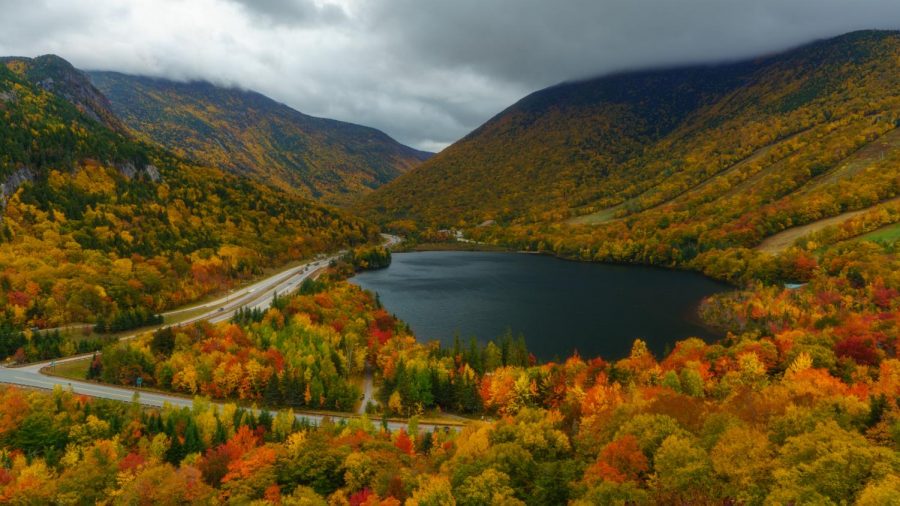Changing Seasons Bring New Safety Precautions
The Echo Lake in the Franconia Notch State Park in New Hampshire is a beautiful location surrounded by stunning forests that get vibrant fall colors each year; photographed from the Artists Bluff Trail in Oct. 2020 (Photo by Abu Asib | The Daily Utah Chronicle)
November 12, 2020
As the seasons change to late autumn and early winter, Utah residents participate in different outdoor activities and consider new safety precautions.
Winter ice and snow on roads are hazards Utah residents have to deal with. Salt Lake City and most other Utah counties require that property owners take care of the snow and ice on sidewalks and driveways, as stated on the website.
The National Safety Council offers safety recommendations for low temperatures on their website. Potential threats can be frostbite and impact injuries if one slips on the ice.
The state takes care of snow and ice on the roads, but drivers still need to be considerate of things like black ice, especially in the colder temperatures, and night vision with changing sunset hours.
Many people drive home in the dark as it becomes rush hour in winter. Other precautions like cleaning and aiming headlights and vehicle care are also encouraged, as well as being aware of carbon monoxide poisoning when heating a car.
It is also recommended that reflective gear for those walking or running in the darker hours be used regularly, especially in the colder months.
The American Hiking Society provides tips for hikers, including wearing layers, waterproof shoes, hats and insulated hydration.
Similar precautions are recommended for those who plan on cycling during the colder weather season with additional emphasis on helmet use, especially when riding on roads.
“Always be aware of your immediate surroundings and be patient, it’s better to get there in due time than not at all,” said Ted Main, a bike mechanic at the University of Utah.
Leah Lange, biology major, spent 4 years on the U’s ski team, and now coaches a team in Montana. She enjoys running and biking in the winter months aside from skiing.
She stressed the importance of both protective gear like helmets and a wardrobe choice.
“I always wear wool and layer. But I think the most important thing is to change into a dry top and socks right away when done so you don’t get the chills,” Lange said.
“We roller ski a lot for training and it is pretty vital that we were helmets. It’s more for car safety, I think being on the road cars are the most dangerous thing and that’s what you protect yourself against.”
During this time of year, there are also more deer on the roads and more wildlife near the hiking trails.
“From what I know, big cats like mountain lions and cougars stalk prey before they attack, so if I noticed it was stalking me, personally I would be louder and just make sure that whatever is hunting me knows I am loud and knows that I am aware of my surroundings. Most wildlife don’t really want to interact with humans, they want to stay away from loud areas. If you have friends with you, you want to keep talking, maybe you want to turn on music just so that you’re making noise wherever you are,” said Mitchell Immamura, a student studying kinesiology.
Immamura also said he plans on having bear spray in his hiking backpack as just another preventative measure. As an avid hiker, he has had a couple of close call interactions with wildlife in his hiking experience.
Additionally, Immamura said it’s important to take specific safety precautions during the skiing season.
“Know where you are or what resort you are going to and looking over the map and the terrain. Theres times when you’re on a run and you’re following the blue and its not a clearly marked path and suddenly we’re on a black diamond,” Immamura said.
Another tool for safety is helmets, which provide protection by dispersing force and absorbing shock before it directly impacts the wearers’ head.
“Helmets apply to everything. If there’s a possibility that you could hit your head on something, then one hundred percent you need to be wearing a helmet,” Immamura said. “A bike helmet or ski helmet is not designed to take multiple hits, they are designed to take one big hit. That helmet will break and that’s it taking all that force into the helmet rather than your head. People say if the helmet broke that’s because it’s done its job.”
Immamura said the fear of slamming his head on a rock while skiing is a bigger fear than an avalanche occurring while he is on the mountain.
Lastly, a common winter safety measure that people often forget is the use of sunscreen.
According to Beaumont Health, “Snow and ice can reflect up to 90% of UV rays. These harmful rays can not only can cause skin cancer, but are also the source of about 90 percent of all wrinkles, according to the U.S. Environmental Protection Agency.”
Skin is subject to windburn, extreme dehydration, and sunburn, especially in the winter months when UV rays are reflected and when the Ozone Layer is at its thinnest and least protective state.







